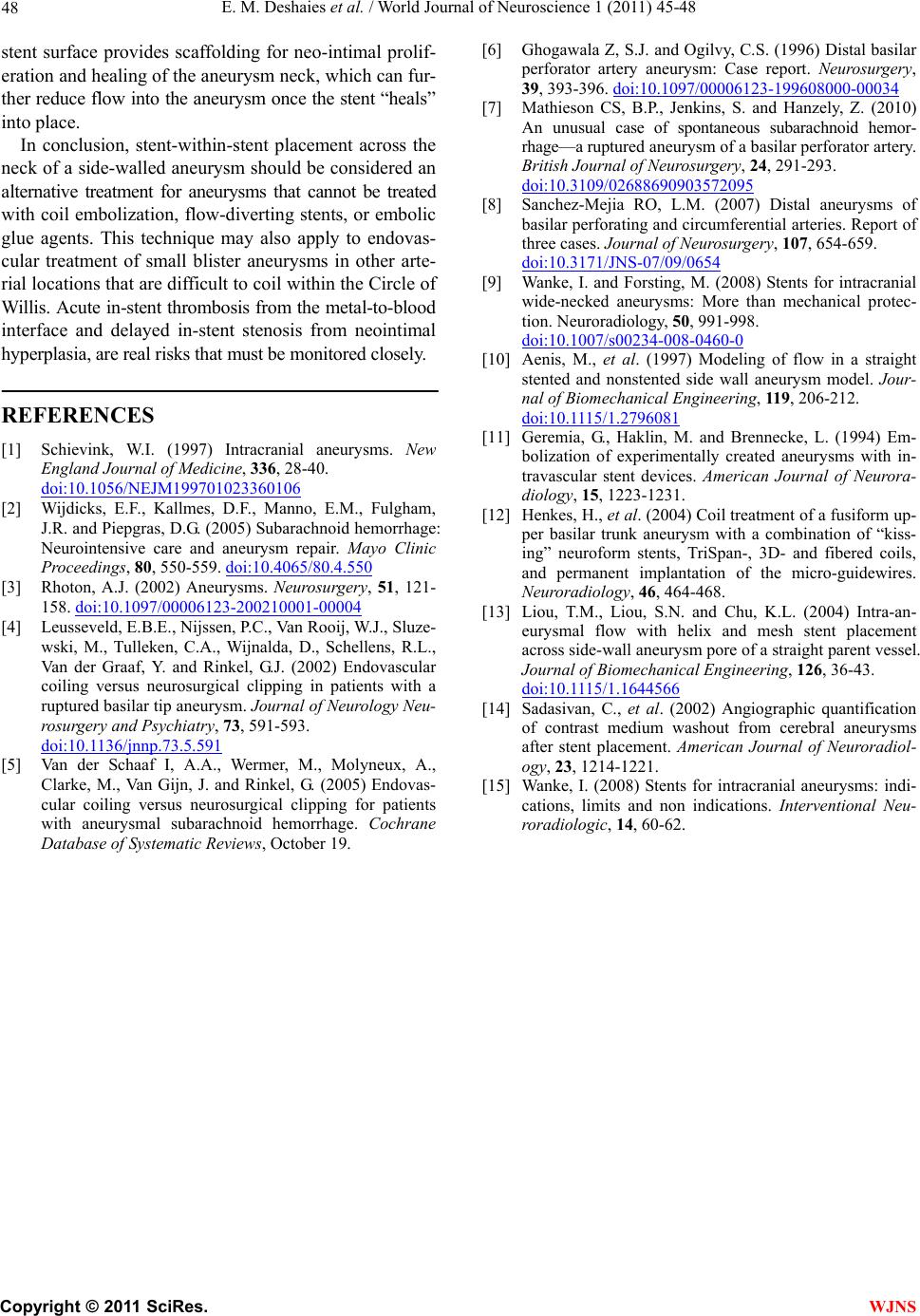
E. M. Deshaies et al. / World Journal of Neuroscience 1 (2011) 45-48
Copyright © 2011 SciRes.
48
[6] Ghogawala Z, S.J. and Ogilvy, C.S. (1996) Distal basilar
perforator artery aneurysm: Case report. Neurosurgery,
39, 393-396. doi:10.1097/00006123-199608000-00034
stent surface provides scaffolding for neo-intimal prolif-
eration and healing of the aneurysm neck, which can fur-
ther reduce flo w into the aneurysm once the stent “he als”
into place. [7] Mathieson CS, B.P., Jenkins, S. and Hanzely, Z. (2010)
An unusual case of spontaneous subarachnoid hemor-
rhage—a ruptured aneurysm of a basilar perforator artery.
British Journal of Neurosurgery, 24, 291-293.
doi:10.3109/02688690903572095
In conclusion, stent-within-stent placement across the
neck of a side-walled aneurysm should be considered an
alternative treatment for aneurysms that cannot be treated
with coil embolization, flow-div erting stents, or embolic
glue agents. This technique may also apply to endovas-
cular treatment of small blister aneurysms in other arte-
rial locations that are difficult to coil within the Circle of
Willis. Acute in-stent thro mbosis fro m the metal-to-blo od
interface and delayed in-stent stenosis from neointimal
hyperplasia, are real risks that must be monitored closely.
[8] Sanchez-Mejia RO, L.M. (2007) Distal aneurysms of
basilar perforating and circumferential arteries. Report of
three cases. Journal of Neurosurgery, 107, 654-659.
doi:10.3171/JNS-07/09/0654
[9] Wanke, I. and Forsting, M. (2008) Stents for intracranial
wide-necked aneurysms: More than mechanical protec-
tion. Neuroradiology, 50, 991-998.
doi:10.1007/s00234-008-0460-0
[10] Aenis, M., et al. (1997) Modeling of flow in a straight
stented and nonstented side wall aneurysm model. Jour-
nal of Biomechanical Engineering, 119, 206-212.
doi:10.1115/1.2796081
REFERENCES [11] Geremia, G., Haklin, M. and Brennecke, L. (1994) Em-
bolization of experimentally created aneurysms with in-
travascular stent devices. American Journal of Neurora-
diology, 15, 1223-1231.
[1] Schievink, W.I. (1997) Intracranial aneurysms. New
England Journal of Medicine, 336, 28-40.
doi:10.1056/NEJM199701023360106
[2] Wijdicks, E.F., Kallmes, D.F., Manno, E.M., Fulgham,
J.R. and Piepgras, D.G. (2005) Subarachnoid hemorrhage:
Neurointensive care and aneurysm repair. Mayo Clinic
Proceedings, 80, 550-559. doi:10.4065/80.4.550
[12] Henkes, H., et al. (2004) Coil treatment of a fusiform up-
per basilar trunk aneurysm with a combination of “kiss-
ing” neuroform stents, TriSpan-, 3D- and fibered coils,
and permanent implantation of the micro-guidewires.
Neuroradiology, 46, 464-468.
[3] Rhoton, A.J. (2002) Aneurysms. Neurosurgery, 51, 121-
158. doi:10.1097/00006123-200210001-00004 [13] Liou, T.M., Liou, S.N. and Chu, K.L. (2004) Intra-an-
eurysmal flow with helix and mesh stent placement
across side-wall aneurysm pore of a straight par e nt v esse l.
Journal of Biomechanical Engineering, 126, 36-43.
doi:10.1115/1.1644566
[4] Leusseveld, E.B.E., Nijssen, P.C., Van Rooij, W.J., Sluze-
wski, M., Tulleken, C.A., Wijnalda, D., Schellens, R.L.,
Van der Graaf, Y. and Rinkel, G.J. (2002) Endovascular
coiling versus neurosurgical clipping in patients with a
ruptured basilar tip aneurysm. Journal of Neurology Neu-
rosurgery and Psychiatry, 73, 591-593.
doi:10.1136/jnnp.73.5.591
[14] Sadasivan, C., et al. (2002) Angiographic quantification
of contrast medium washout from cerebral aneurysms
after stent placement. American Journal of Neuroradiol-
ogy, 23, 1214-1221.
[5] Van der Schaaf I, A.A., Wermer, M., Molyneux, A.,
Clarke, M., Van Gijn, J. and Rinkel, G. (2005) Endovas-
cular coiling versus neurosurgical clipping for patients
with aneurysmal subarachnoid hemorrhage. Cochrane
Database of Systematic Reviews, Octobe r 19 .
[15] Wanke, I. (2008) Stents for intracranial aneurysms: indi-
cations, limits and non indications. Interventional Neu-
roradiologic, 14, 60-62.
WJNS